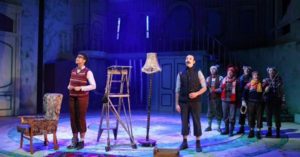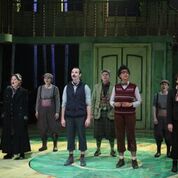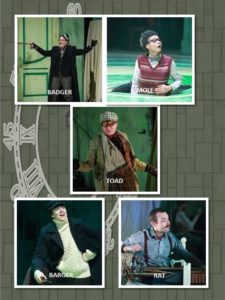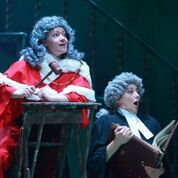
 (4 / 5)
(4 / 5)
“The Wind in the Willows” is the 2017 Christmas production at Sherman Theatre, Cardiff, and offers a banquet of creativity to feast upon.
Kenneth Grahame’s inveterate didactic children’s novel of 1908, “The Wind in the Willows” has been adapted for the stage an enormous amount of times, especially at Christmas, and this is likely to continue.
A cursory glance at reason productions in Wales, by both professional and amateur companies, such as Black Rat Productions at The Gate in Cardiff, in 2010, Gwent Young People’s Theatre 2008 show at Abergavenny Castle, (that sounded like fun!), to name just two.
“The Wind in the Willows” follows the adventures of the anthropomorphic animals Mole, Rat, Badger, Toad, and their friends.
Kenneth Grahame’s idea was to promote moralistic themes that most parents would like their children to follow.
Themes such as showing hospitality as epitomised through the characters of Rat and Badger and conversely, criticising it through the depiction of Toad. The Pastoral environment to be preferred over city life. The ugliness of industrialisation and the rapid developments in technology, shown in Toad’s infatuation of the motor car and, as a consequence, his reckless driving, its ability to destruct the peace and tranquility of the countryside. This particular theme bearing a highly relevant resonance to environmental difficulties facing the world a hundred years after the book was written. A sense of adventure is another theme that pervades throughout the story. Toad’s road trips. Mole’s desire to explore the world beyond her own limited one, and even Rat’s temporary desire to have a life on the ocean’s waves. However, the joy of returning to the stability of the home is also a theme that Grahame promotes. Finally, the anthropomorphic characters in the story each have their own characters. Badger is the oldest, and consequently, the wisest, and the others respect him for that. Within the pecking order, next comes Rat, slightly younger but showing a certain degree of maturity, whereas Mole is a young man on the verge of making his way in society and excited about the prospect of doing this, but needing a firm hand of guidance to steer the path. Finally comes Toad, the spoiled brat used to getting his own way and lacking maturity.
“The Wind in the Willows” Production Team
Credits
Gaolers Daughter: Rebecca Killick
Chief Weasel: Hannah McPake
Mole: Jessica Murrain
Badger: Zara Ramm
Rat: Dominic Rye
Toad: Keiron Self
Portly: Emma Cooney
Director: Lee Lyford
Writer: Mike Kenny
Lighting Designer: Kevin Treacy
Composer: Conor Mitchell
Musical Director: Gareth Wyn Griffiths
This is an energetic, funny and likeable production with a vast array of creative ideas on display, testament to the brilliance of Lee Lyford’s direction.
Beds on castors on a revolving stage with makeshift oars provide a degree of realism when depicting a boat on a river, or a boat crew swiftly passing through.
Bunnies on pogo sticks and the scene getting the largest laughter, (at least amongst the adults), is of a small remote control red sports car whizzing across an empty stage, and thereby fuelling the desire for the hopeless infatuated Toad to steal it. Then offstage you hear an almighty crash and the car returns with smoke emerging from it, shortly afterward followed by a dark blue police car in pursuit.
I also like the director’s use of physical theatre at times – it works very well.
Mike Kenny’s adaptation of “The Wind in the Willows” is faithful to the story and highlights the main themes well.
The first impression of the stage design is one of greenness. Thereby tying in with the environmental issues within the story. A disheveled Toad Hall has a winding staircase, stage left, leading to a landing with five windows. Above which hangs a splendid candelabra. Below the landing space is a piano. The ceiling looks in a very sorry state and one expects daylight to be appearing any day soon. Large Green doors which play a very active role in the play are located stage left and right. The green painted central space has circular revolving stages within it. Bookcases and furniture have sheets draped over them, heightening the sense of desolation. A trapdoor is utilised centre stage.
The design of animal costumes is another highlight. When the unbearably cute young hedgehogs appeared in Badger’s home, many young children let out involuntary aahs!
Composer Conor Mitchell, introduced a number of catchy tunes sung and played during the performance. In fact, I heard an adult member of the audience, whistling the final song in the foyer post show.

The Cast
It would be unfair to single out any individual member of the cast as they are universally excellent in their roles. The cast portrays many other characters and animals other than those mentioned in the production credits above. Multi-talented, they also played a veritable orchestra of instruments. Cello, violins, triangles, banjo, ukulele and accordion, and probably others that I missed. All held together by the busy Gareth Wyn Griffiths on the piano. They also possess fine voices to accompany the songs, both individually and in chorus.

I feel that the annunciation by all actors was uncommonly fine. It doesn’t surprise me to find that Zara Ramm has a successful career narrating the audio books for the novels of Jodi Taylor in particular, and others. Ms Ramm, I have seen on stage before – twenty five years ago at the old Orange Tree Theatre in Richmond-upon-Thames in David Edgar’s “Saigon Rose”. This was 1992 and I remember the production well to this date, and the brilliance of the very young cast playing in an incredibly small, space. All I can say is that during the intervening twenty-five years, Ms Ramm has aged far better than myself!
Overall, this is a production of the highest level suitable for children of all ages and adults. I saw a number of children as young as 3 or 4 in the audience, and towards the end, I glanced around and was amazed by the way the production had captivated them. Many of them leaning forward in their seats with their eyes glued to the stage.
My only criticism, (and it is a minor one), would be at times the play is a little wordy, and slower paced, but, for that matter, so is the story, perhaps making this inevitable to drive the plot forward.
For adults, within “The Wind in the Willows”, there is enough on display to pass an enjoyable couple of hours in an innocent, wholesome theatrical environment, and, like me, I feel that you would emerge greatly encouraged by what you have experienced. For children’s theatre is vital in nurturing the desire and creating the need to the future adult theatregoer, and shows like this leave you optimistic for the future of our beloved industry.
If you are an adult without a child to take with you, and you feel a little self-conscious attending by yourself, then I suggest you should borrow one from somewhere. It’s that good!
For tickets and times please go to the link
Duration: 2 hours including a 15-minute interval
Suitability: All

Roger Barrington

